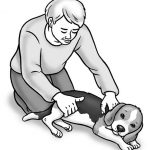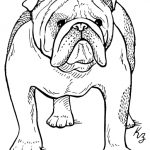In This Chapter
- Grooming for good health and a better relationship
- Brushing for a healthy coat
- Keeping your Beagle critter free
- Giving your Beagle a bath
- Tending to ears, eyes, feet, and bottom
- Cleaning your Beagle’s teeth
- Dealing with winter-time concerns
Many people choose to share their lives with Beagles because the Snoopy-dog is a relatively low-maintenance canine, at least when it comes to grooming. Those who don’t want to pay for a Poodle’s monthly trip to a groomer or sit down each day to remove the mats from a Golden Retriever’s coat undoubtedly appreciate the Beagle’s no-fuss, no-muss coiffure.
But just because the Beagle has a wash-and-wear hairdo doesn’t mean that she doesn’t need regular grooming. Not only does she need grooming to stay clean and healthy, she also needs grooming to have one-on-one time with you. In addition, regular grooming provides a great opportunity to examine your little hound for lumps, bumps, cuts, and other signs that she’s not in tip-top condition.
This chapter gives you the basic info you need to keep your Beagle well groomed from the end of her nose to the tip of her tail — and everywhere in between.
Giving Her the Brush-off
A thorough brushing once or twice a week is crucial to keep your Beagle’s coat and skin healthy. The brushing action gently stimulates the skin and distributes the skin’s natural oils throughout the coat. Brushing also helps to control your Beagle’s shedding — or, at least, to reduce the amount of hair that would otherwise get into your carpets, furniture, or clothes.
You only need one tool to brush your pup: a brush! The best ones have soft bristles; alternatively, you can use a curry comb.
Easy brushing goes like this:
1. Start by getting yourself and your Beagle into comfortable positions.
A safe way to brush your dog is to have her lie down — Chapter
Schooling Your Beagle explains how to teach her to lie down on command — and roll over onto her side, as shown in Figure 10-1.
Unless you have a professional grooming station with the means to secure your dog safely, don’t place her on a raised surface such as a table. She could be at risk for injury if she decides to end the brushing session prematurely and jump down.
2. After she’s lying down and relaxed, gently stroke her entire body in the direction of the hair growth with the soft-bristle brush or curry comb.
3. After you’re done with the first side, gently roll her over and do the other side.
Piece of cake!
It’s hard to imagine that any Snoopy-dog could hate being brushed, but if yours is one of those rare individuals, help is at hand. If yours is a hard-to-brush hound, try employing one or both of the following tactics:
– Turn on the TV. No, I’m not kidding. Put on your favorite trashy television show (meaning one that doesn’t require much of your attention) and invite your Beagle to snuggle up with you. When she does, pet her gently and help her relax. Then, when you see that she’s headed toward Dreamland, get out the brush and try a few gentle strokes. If she objects, stop the session immediately but try again later. If she doesn’t object, tell her in a soothing voice what a good girl she is and continue brushing.
– Bribe her. Any time you and your Beagle are having a lovefest (also known as a petting party), give her a treat. Then, as she’s nibbling the treat, wield the brush for a stroke or two. If she doesn’t object, give her another treat and praise her for being a good girl. Gradually build up the number of brush strokes you give her. Pretty soon, she’ll adore being brushed.
Figure 10-1: Placing your Beagle on her side can make brushing easier.
Establishing a No-Critter Zone
They’re teeny-tiny, almost microscopically small — but they can make your Beagle’s life (and yours!) miserable. I’m talking about the fleas and ticks that hitchhike their way to happiness on the body of your hound and countless other canines.
Fighting those fleas
Just one flea can drive your dog to distraction. A single bite will cause your four-legged friend to get itchy. Worse, if she’s allergic to the fleas, she may scratch so much that she’ll lose part of her coat, cause her skin to bleed, and open the door to all kinds of tough-totreat infections. Even if she’s not allergic, without relief from fleas your dog may become anemic, because the flea’s dinner of choice is canine blood. However, the flea is an equal opportunity parasite; it has no problem jumping from your Beagle to you. When it does, you’ll be scratching, too.
And of course, the flea is not a solitary critter. If you find one flea bite on your dog, you can be sure that a multitude of fleas has been feasting on her.
Hunting for fleas
How do you know if your Beagle has fleas? If she begins scratching almost constantly, take a look at her tummy. Many black specks on the skin of her stomach and/or groin may signal the presence of flea dirt — the blood the flea expels after it’s dined on your dog.
Tip
Moisten any suspected flea dirt with water. If the specks turn red, your Beagle’s got fleas.
You may even see a tiny little critter or two scampering on your dog’s skin. Still not sure? Take a flea comb and run it through your Beagle’s coat. If she’s got fleas, you’ll see them crawling around the teeth of the comb. (A flea comb is a small comb with very fine teeth that are very close together. Its single purpose is to help you deal with fleas on your dog.)
Zapping the little buggers
Fortunately, you can give your Beagle permanent relief from fleas. In recent years, pharmaceutical companies have unveiled a variety of products that successfully eradicate these useless parasites. Some stop the flea’s eggs from developing, thus causing the population to die off because it can’t reproduce. Others kill the adult fleas that make the mistake of biting the treated dog.
Even better are the many flea-control products that are masters of multitasking. For example, the chewable pill that stops flea eggs from developing also kills parasites such as heartworm (which can be fatal if untreated), hookworm, roundworm, and whipworm. A topical product that zaps adult fleas does the same to ticks. Both are available only with a veterinarian’s prescription — which leads me to strongly suggest that you consult your veterinarian before starting any flea control program. For one thing, your vet can steer you away from outdated — and frankly, not terribly effective — remedies, such as flea collars, shampoos, and dips.
Banishing those ticks
Ticks are a real danger to canine and human health. They transmit serious diseases such as Lyme disease and Rocky Mountain spotted fever. Antibiotics can zap these diseases, but experts agree that prevention is the better strategy to dealing with these maladies.
Prevention starts with checking your dog often to see if she has any ticks on her body and removing them properly. Depending on the type of tick and how much it’s feasted on your Beagle, it will look like a bump that’s anywhere from the size of a pinhead to a pencil eraser and be dark brown to brownish-grey in color.
You’ll need a pair of rubber gloves, tweezers, a needle, rubbing alcohol, cotton balls, a bowl, doggy shampoo, and water.
To remove a tick, have your dog sit or lie down. Then:
1. Put on the gloves and grab the tweezers.
2. Grab the tick’s body with the tweezers, and pull it straight off the dog.
Don’t twist or jerk while you pull. That way, you’re more likely to get the whole tick, not just the headless body.
3. Check to make sure you got the head as well as the body.
If the tick’s head appears to have been left behind, remove it from the dog’s skin with a needle that’s been dipped in rubbing alcohol.
4. Put the tick in a bowl of alcohol to kill it.
5. Clean the area from which you pulled the tick with a cotton ball that has a tiny amount of shampoo on it. Rinse with water and dry. Then use another cotton ball to place a dab of rubbing alcohol on the site.
6. Watch for signs of tick-borne disease.
Those signs include appetite loss, weight loss, fever, lethargy, and stiffness. Such symptoms probably will appear four to ten days after you’ve removed the tick, although they may take longer to show up. No matter when your Beagle shows such signs of trouble, though, take her to your veterinarian.
Lather Up! Bathing Your Beagle
Every Beagle needs to be bathed periodically — but unlike you, your Snoopy-dog doesn’t need a daily sudsing, or even a weekly one. A monthly bath should keep her clean and sweet smelling, but if she happens to get really dirty between regularly scheduled baths, an extra turn in the tub is fine.
From dirty dog to washed dog
Luckily for you, a Beagle is relatively small and easy to bathe. But before you put your Beagle in the tub, gather the gear you need:
- Shampoo made just for dogs
- A hand-held shower attachment or bowl for rinsing
- Cotton balls to protect the ears from water
- A rubber bathmat to keep her from her from slipping in the tub
- A couple of big, fluffy towels
Tip
Don’t forget about yourself! If you’re bathing your dog in a bathtub, place a couple of towels on the floor to cushion your knees. And wear something impervious to water: a waterproof apron or even a swimsuit. (Yes, you will get wet. Maybe very wet.)
After you gather these goods, do two more things:
– Protect her ears. For dogs, water in the ear is very uncomfortable. To keep water out of the ears, place a cotton ball in each.
– Dilute the shampoo. Add three or four units of water to every unit of shampoo you plan to use. That way, the shampoo will lather and rinse more easily.
Now you’re ready to get bubbly! Follow these steps to safely bathe your Beagle:
1. Lay the bathmat in the tub to keep your Beagle’s feet steady.
2. Carefully lift her into the tub.
Keep a steady hand. If your Beagle hasn’t yet learned to appreciate the joys of bath time, keep a hand on her while she’s in the tub so she can’t hop out easily. And in the unlikely event that she does make a break from the tub, keep the bathroom door closed so she doesn’t go racing all over your home before you’ve finished.
3. With a hand-held shower attachment or a small bowl, pour warm (never hot!) water over your dog, making sure the water goes all the way down to the skin.
Start at the top of the head and neck, and then wet the length of the backbone. After that, water her sides, chest, legs, and tail.
4. Apply enough diluted shampoo to create lather all over the dog’s body.
Don’t OD on the suds. Billowy clouds or multiple floating bubbles mean you’ve laid the lather on way too thick.
5. When your Beagle’s in a full-body lather, use the shower attachment or bowl to rinse her off.
Perform the rinse in the same order you performed the initial wet-down: front to back, top to bottom.
Remember
Make sure you get every last bit of soap off your Beagle; an incomplete rinse will leave her skin flaky, dry, and itchy. Keep pouring on the water for five minutes or until the rinse water runs clear — whichever comes last.
6. Block the tub and let her shake.
With your Beagle still in the tub, hold a bath towel up in front of you so it’s between you and your dog. At this point, she’ll shake the excess water off her coat — but thanks to the towel, that excess water won’t get on you.
7. Gently lift your Beagle out of the tub and wrap her in a dry towel to speed up the drying process.
Don’t rub, though; instead, blot the excess water from the coat and skin.
8. Let your dog indulge in an after-bath running frenzy — after which you can towel her some more.
Beagles have short hair and small bodies, so you don’t need to bother with a hair dryer.
And . . . that’s a wrap! You’re done (except for cleaning up the mess in the bathroom, of course)!
Defusing the Beagle stink bomb
Sometimes your little hound may, well, stink. She may smell bad because she’s rolled around in something disgusting, such as a dead animal. That’s normal doggy behavior — but if your dog engages in such behavior, her next stop should be the bathtub.
At other times, an ear infection or gum disease may be causing her icky odor. Both conditions can be cleared up with medication, regular cleaning, and possibly, a change in diet. Your vet can help you relieve both conditions.
If, however, your normally sweet-smelling Snoopy-dog suddenly sports a foul odor that you can’t attribute to any single cause, take her to your vet. A sudden change in odor may signal the onset of a serious condition.
Remember
Bottom line: Don’t assume your Beagle’s BO is normal doggy odor. Chances are it’s not.
Tending to Eyes and Ears
A Beagle’s eyes and ears need special care, but you need not be a visual or audio specialist to provide the basics.
Cleaning the windows to the soul
Keeping your Beagle’s eyes clean is a snap and really only needs to be done whenever you see any little eye crumbs at the inner corners. Just like with you, these crumbs are most likely to appear after she’s had a nap — and after a nap may be the best time to remove them.
The only equipment you need is a bit of cotton or small cloth. To tidy up your little friend’s eyes:
1. Have your dog sit in front of you.
2. Gently wipe the inner corners of her eyes with the cotton or cloth.
Warning!
If you see any goopy, colored discharge from the eye, a red or inflamed eye, cloudiness of the eye, sensitivity to light, or if your dog frequently paws at her eye, take her to a veterinarian as soon as possible. She may have a serious vision problem, and prompt treatment is essential.
Wiping out the ears
A Beagle’s ears need more attention than the eyes do. That’s because the little hound’s long, floppy ears provide a perfect breeding ground for fungi and bacterial infections. The ear flap (that’s the floppy part) covers the rest of the ear and restricts air flow in and out of it. The result: a perpetually moist ear and lots of potential for ear trouble.
Weekly cleaning can keep the ears dry and help them stay infection free. To do the job right, you need some cotton balls and an ear cleaner made especially for dogs.
Tip
Ear cleaners are available from your veterinarian, but you can also make your own by combining two parts water with one part white vinegar in a squirt bottle.
After you’ve secured your Beagle’s ear gear, follow these steps:
1. Have your dog either sit or lie down.
2. Squirt a little bit of cleaner into the ear.
Tip
If your dog doesn’t like to have cleaner squirted directly into her ear, saturate the cotton ball with ear cleaner. Then, place the cotton ball in the dog’s ear (but not too far into the canal). Squeeze the cotton ball so the cleaner flows from the cotton ball into the ear canal.
3. Fold the flap over the ear and massage the base of the ear for about one minute. Let your Beagle shake her head.
4. Use your cotton ball to clean the visible parts of the ear, as shown in Figure 10-2.
Figure 10-2: Regular cleaning keeps your Beagle’s ears healthy.
Warning!
If your Beagle shakes her head a lot, runs her ears along the ground often, paws at her ears, or has a dark, goopy discharge, she probably has an ear infection. The same is true if your dog’s ears smell like baking bread. Take her to the vet. Ear infections are not a trivial matter. They’re very painful to your Snoopy-dog — and if left untreated can result in permanent hearing loss.
Brushing Those Pearlies
When your Beagle yawns, do you want to give her a breath mint? If so, your dog isn’t alone. According to the American Veterinary Dental College, more than 80 percent of all dogs and cats show signs of dental disease by the age of 3 — and bad breath is a sure sign that dental disease is present (see Chapter
Dealing with Health Issues). This condition not only makes your Beagle not so nice to be near, but also could lead to tooth loss and even bacterial infections in other parts of the body.
However, all those problems are preventable. All you have to do is brush your Beagle’s teeth once daily, or at least three or four times a week. Brushing removes the food particles and other crud that coats the teeth with plaque and creates a breeding ground for dental disease.
Before you tackle your Beagle’s teeth, you need to have these items on hand:
– A soft toothbrush that’s designed for either pets or children
– Toothpaste created especially for dogs
Warning!
Don’t use human toothpaste; it can upset your Beagle’s stomach. Besides, doggy toothpaste — which comes in flavors like chicken and beef — will taste much better to your Beagle.
Here’s how to do the job:
1. Put enough toothpaste on the toothbrush to cover half to two-thirds of the brush. Have your dog sit in front of you.
2. Lift your dog’s lips and gently brush the outer surfaces of her teeth. Figure 10-3 shows how to pull back the lip.
Brush vertically, from one side of the mouth to the other; one pass ought to do it. (Your dog probably won’t tolerate any more brushing than that!) Don’t worry about the inner surfaces; your Beagle’s tongue keeps those areas clean.
And unlike when we brush our teeth, your Beagle won’t need to rinse or have a towel nearby for dainty mouth wipes.
Tip
If your four-legged friend has never used a toothbrush before, get a finger brush from your local pet supply store, or just wrap some gauze around your finger. Rub her gums gently with the gauze or finger brush until she’s used to having you work with her mouth. Then, gradually introduce her to the toothbrush.
3. Bribe your Beagle with a short walk or play with her for a few minutes after each session with the toothbrush.
A Beagle who can expect something nice to happen right after a brushing is much more likely to put up with the procedure than one who’s got nothing to look forward to.
4. Brush at the same time every day.
Having a schedule helps you to remember to brush daily. An added bonus: If your Beagle expects her brushing at a particular time, she may be more amenable to the procedure.
Tip
Alas, some dogs simply don’t tolerate having their teeth brushed. If your dog is one of them, try giving her special plaque-reducing foods and plaque-fighting treats.
Figure 10-3: Brush your dog’s teeth daily to keep her healthy all over.
Trimming the Tootsies
If you saw a Beagle clunking down the street wearing the latest pair of Manolo Blahnik high heels, you’d probably think she looked pretty silly, right? And you’d probably shudder over the strain the poor dog would be putting on her feet and legs.
Well, if you let your Beagle’s toenails grow too long, your Snoopydog suffers the same way she would if she had her own pair of Manolos — and she doesn’t look nearly as good. Overgrown toenails throw your Beagle off balance and can cause her to suffer any number of painful injuries. Regular nail trimmings, however, can prevent such mishaps and keep your Beagle on her right (and left) feet.
Remember
The nails should be short enough to be off the ground when she’s standing still, and her dew claws (the nails that are found higher up on the leg near the ankle) should be trimmed short enough to prevent them from curving back into the skin of the leg.
You only need a few things to give your dog a pedicure:
– A pair of nail clippers designed just for dogs
– Styptic powder (available in pharmacies) or baking flour in case you cut the quick
– Lots of yummy treats (at least 20 of them!)
Here’s how to trim her toenails and help your Beagle put her best foot forward:
1. Have your dog either sit or lie down.
She should be relaxed, and you should be able to reach her paws.
Tip
TV time can be a good time to give your dog a nail trim.
That’s because many dogs relax when they watch the tube with their people.
2. Look for the quick, the blood vessel inside the toenail that runs almost to the end of the nail.
Light nails make the quick easy to see; it’s the pink area inside the nail. With dark nails, you can’t see the quick, so you have to guess where it is.
3. Pick up one of your Beagle’s paws, and gently squeeze it to extend the nails a bit. Place the clippers around the very end of one nail, as Figure 10-4 shows. Squeeze the clippers quickly to trim off the nail tip.
4. Continue trimming a little at a time until you see the black dot in the center of the trimmed nail.
The black dot is where the quick starts.
5. Stay calm and apply some styptic powder or baking flour to the nail if you cut the quick.
If you accidentally trim the nail too short and hit the quick, the nail will bleed — a lot. Don’t panic. The bleeding will stop very quickly after you apply styptic powder or flour.
6. Give your Beagle a treat each time you finish trimming a nail.
Keep rewarding her, one nail at a time. Many dogs decide that pedicures are tolerable if they get a few treats during the process.
Figure 10-4: Be careful to avoid cutting the quick when you trim the nail.
Addressing Your Beagle’s Bottom Line
No question about it: A Beagle’s bottom is cute. One look at that wiggly tush (the wiggles come from that perpetually wagging tail) and you’ll be hooked — if the Snoopy-dog’s big soulful eyes haven’t won your heart already.
But at times, the Beagle’s bottom may turn into a real pain in the you-know-what for her. You may see her rub her derrière along the ground after she poops, or perhaps her rear end is sporting a very strong and totally unpleasant odor. Either of these conditions may indicate a common but painful problem: full anal sacs.
Every Beagle has two of these little sacs, one on each side of her anus (also known as the rectum, the opening through which the dog poops). Normally when a dog poops, the sacs release a little bit of incredibly strong-smelling fluid that helps the dog mark territory and leave her calling card. In other words, the fluid identifies the deposit that your Beagle leaves after a bowel movement as her deposit.
Sometimes, though, the glands around the anus produce more fluid than the sacs are capable of holding, or the small openings in the sacs become clogged with fluid. That’s when your Beagle may start dragging her butt along the ground — a behavior that experts call scooting — and you notice a very strong-smelling odor emanating from her tush.
The way to stop the scooting, eliminate the odor, and relieve your Beagle’s discomfort is to release — or, in veterinarian-speak, express — the excess fluid from the anal sacs. Any veterinarian and most professional groomers are happy to do this literally stinky and certainly unappealing job for you for a nominal charge. But if you want to do the job yourself, you can.
You will definitely want to have some latex gloves and plenty of tissues for this procedure. After the worst is over, you’ll also need some petroleum jelly.
Here’s what to do:
1. Take your Beagle to an area such as the bathroom or anyplace else where the floor can be cleaned easily.
2. Put on some latex gloves.
3. Lift your dog’s tail with one hand, and with the other pick up some tissues.
4. With the tissued hand, feel around the anus for the anal sacs, which are located at approximately the four o’clock and eight o’clock positions with respect to the anus (see Figure 10-5).
If they’re full, you’ll feel two little bumps at those positions.
5. Cover the anus with tissues (trust me, you do not want to skip this step!).
6. With your fingers on the anal sacs (remember four o’clock and eight o’clock), gently press inward.
If your fingers are placed correctly, you’ll feel the sacs begin to empty, and you’ll see fluid on the tissues that cover the anus. If nothing happens, try repositioning your fingers until you feel the sacs begin to empty.
7. Continue until no more fluid emerges onto the tissues.
8. Apply a little bit of petroleum jelly to the anus and surrounding area to soothe them.
Figure 10-5: Be gentle when you express your Beagle’s anal sacs.
Winterizing Your Beagle
Keeping your Beagle happy and healthy and comfortable in all seasons isn’t hard to do. The Snoopy-dog is a hardy soul, and a few adjustments are all that’s needed to keep her in tip-top condition all year round, especially during the winter.
The winter-time Beagle may experience the same cold-weather phenomena as the winter-time human: dry, flaky skin. But while human beings can slather on moisturizers and lotions to combat the dryness, your Beagle’s dry skin may need treatment from within. Make sure your dog gets plenty of water, and talk with your veterinarian about adding fatty acid supplements to her diet.
We humans have lots of shoes and boots with which to cover our feet during the winter, but dogs generally have the dubious pleasure of walking barefoot over snow and ice. Be considerate of your Beagle. If she’s running outside in the snow, make sure you remove any snow or ice that’s accumulated between her toes after she gets inside. Leaving those little ice balls intact can spread your Beagle’s toes in a most uncomfortable fashion.
During the winter, your considerate neighbors may sprinkle rock salt on their sidewalks to make them less slippery. But while that salt helps keep you upright, it causes your Beagle’s sensitive paw pads to dry out and burn. When you and your pooch walk outside during snow season, try to avoid walking her over salted surfaces. If you can’t avoid those surfaces, thoroughly rinse your Beagle’s feet with warm water when you come back inside.
Bundling up BeagleDoes your Beagle need a sweater to keep her toasty warm during the winter? Probably not, but that doesn’t mean she wouldn’t appreciate a little help staying warm during those cold winter walks. Pet stores and upscale pet clothing catalogs abound with sweaters and coats to protect Beagles and other canine snow-bunnies (how’s that for a contradiction in terms?) from the ravages of Old Man Winter. How do you know which size is right for your Beagle? First, stretch a tape measure from the base of her neck to the base of her tail. This is her top line measurement. Then, measure her chest by wrapping the tape measure around her trunk at the widest point, just behind her front legs. Those two measurements can help you determine your Beagle’s clothing size. Generally, Beagles wear a medium — but as with so many other issues, your mileage may vary. |
by Susan McCullough




































